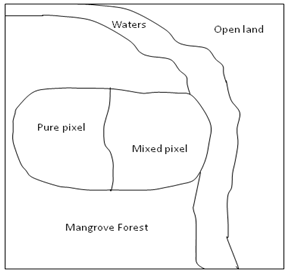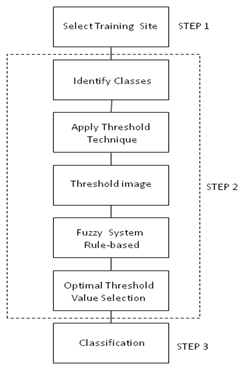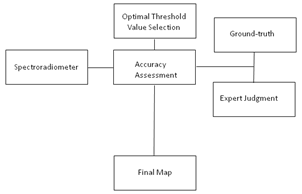-
Paper Information
- Next Paper
- Previous Paper
- Paper Submission
-
Journal Information
- About This Journal
- Editorial Board
- Current Issue
- Archive
- Author Guidelines
- Contact Us
International Journal of Agriculture and Forestry
p-ISSN: 2165-882X e-ISSN: 2165-8846
2012; 2(6): 300-306
doi: 10.5923/j.ijaf.20120206.06
Thresholding and Fuzzy Rule-Based Classification Approaches in Handling Mangrove Forest Mixed Pixel Problems Associated with in QuickBird Remote Sensing Image Analysis
Othman Mohd , Nanna Suryanna , Shahrin Sahib Sahibuddin , Mohd Faizal Abdollah , Siti Rahayu Selamat
Faculty of Information and Communication Technology, Technical University of Malaysia Melaka, 76100 Melaka, Malaysia
Correspondence to: Othman Mohd , Faculty of Information and Communication Technology, Technical University of Malaysia Melaka, 76100 Melaka, Malaysia.
| Email: |  |
Copyright © 2012 Scientific & Academic Publishing. All Rights Reserved.
Mangrove forest is an important costal ecosystem in the tropical and sub-tropical coastal regions. It is among the most productivity, ecologically, environmentally and biologically diverse ecosystem in the world. With the improvement of remote sensing technology such as remote sensing images, it provides the alternative for better way of mangrove mapping because covered wider area of ground survey. Image classification is the important part of remote sensing, image analysis and pattern recognition. It is defined as the extraction of differentiated classes; land use and land cover categories from raw remote sensing digital satellite data. One pixel in the satellite image possibly covers more than one object on the ground, within-class variability, or other complex surface cover patterns that cannot be properly described by one class. A pixel in remote sensing images might represent a mixture of class covers, within-class variability, or other complex surface cover patterns. However, this pixel cannot be correctly described by one class. These may be caused by ground characteristics of the classes and the image spatial resolution. Therefore, the aim of this research is to obtain the optimal threshold value for each class of landuse/landcover using a combination of thresholding and fuzzy rule-based classification techniques. The proposed techniques consist of three main steps; selecting training site, identifying threshold value and producing classification map. In order to produce the final mangrove classification map, the accuracy assessment is conducted through ground truth data, spectroradiometer and expert judgment. The assessment discovered the relationship between the image and condition on the ground, and the spectral signature of surface material in identifying the geographical object.
Keywords: Mangrove, Remote Sensing Satellite Image, Threshold, Fuzzy Rule-Based Classification
Cite this paper: Othman Mohd , Nanna Suryanna , Shahrin Sahib Sahibuddin , Mohd Faizal Abdollah , Siti Rahayu Selamat , "Thresholding and Fuzzy Rule-Based Classification Approaches in Handling Mangrove Forest Mixed Pixel Problems Associated with in QuickBird Remote Sensing Image Analysis", International Journal of Agriculture and Forestry, Vol. 2 No. 6, 2012, pp. 300-306. doi: 10.5923/j.ijaf.20120206.06.
Article Outline
1. Introduction
- Mangrove area is an important costal ecosystem in the tropical and sub-tropical coastal regions. It is among the most productivity, ecologically, environmentally and biologically diverse ecosystem in the world. Managing of mangrove is challenging and complex balancing between ecosystem protections and enabling human to enjoy and use these natural resources. Knowledge to obtain information on ecosystem including mangrove community is important.With the improvement of remote sensing technology, it provides the alternative for better way of mangrove mapping because covered wider area of ground survey. Furthermore it reduces human energy, time and cost. The information from remote sensing satellite has been recorded remotely andtransformed into remote sensing images. The information that may be generated is directly linked the related characteristics of the images and produces spatial resolution (pixel size), spectral resolution (wavelength ranges utilized) and spatial extend (ground area represented). Reflectance from each pixel is measured at many narrow, contiguous wavelength intervals. Nevertheless the increasing of spatial resolution associated with most satellite sensor systems imaging is higher than the normal sizes of object on the ground.Image classification is the important part of remote sensing, image analysis and pattern recognition[1]. It is defined as the extraction of differentiated classes; land use and land cover categories from raw remote sensing digital satellite data. The image classification also offered the opportunity to recognize and individualize objects such as individual trees species, buildings, roads, and so on. The techniques of image classification can be divided into supervised classification and unsupervised classification[2] stated that one pixel in the satellite image possibly covers more than one object on the ground, within-class variability, or other complex surface cover patterns that cannot be properly described by one class. Although the detail information is recorded, yet there have a serious problem to recognize a particular geographical object due to overlapping of two or more associated spectral properties. A pixel in remote sensing images might represent a mixture of class covers, within-class variability, or other complex surface cover patterns. This pixel cannot be correctly described by one class. These may be caused by ground characteristics of the classes and the image spatial resolution. Since one class cannot describe these pixels, thresholding is most applicable methods used to separates the problems of overlapping pixel. It is widely accepted that selection of correct threshold will lead to good extraction of object[3]. Unfortunately according to Hong Yan,[4] the main issue is to choose an optimal threshold value so that the misclassification of image pixels is kept as low as possible. According to[5], although many and good training areas are selected, misclassification occurs to some extent in case of classification of mangrove area by any classifiers. It is because there are pixels having similar spectral reflectance in the categorized area such as land area, mangrove forest and water.Fuzzy logic theory have been widely use in variety of problem domain. It has invaded a lot of fields such as fuzzy control systems, fuzzy image processing and predictably, fuzzy classification of remote sensed data. The use of fuzzy rule-based classification has become of great interest because of its capacity to provide more useful information for geographic information systems[6]. The fuzzy rule-based classification, or pixel unmixing, estimates the contribution of each class in the pixel.[7] stated that in supervised classification, mixed pixels usually result in misclassification since the mixed pixels are different spectrally from pure pixels of the individual vegetation types. With fuzzy classification, mixtures estimation, spectral mixture analysis and subpixel classification information is obtained about the fraction of different classes within a mixed pixel. This paper discusses on the use of thresholding selection techniques and fuzzy rule-based classification to identify landcover and mangrove species using QuickBird satellite image. The main focus of this study is to classifying mangrove species using two different thresholding methods; as well as to improve the accuracy of mangrove species through the development of new optimal threshold technique base on Fuzzy rule-based classification. Furthermore the classification results obtain from these methods will be validating through ground truthing data and expert judgement before producing the final mangrove mapping. By doing this; it should help the administrator to distinguish mangrove species group and to identify the wavelength regions that defines the inherent spectral curve between each mangrove species.
2. Related Works
- Part of this paper is intended to discuss the state of art the combination between thresholding techniques and fuzzy rule-based classification which at the end will provide information of the proposed algorithm for mangrove classification. In other words, they are many techniques have been studied but the decomposition of mixed pixel problem using thresholding techniques and fuzzy rule-based classification still have need more attention for both the ongoing and future research.Mangrove forest consists of particular dominant species plays an important role to protect shoreline from erosion, to stabilize banks and coastlines besides it become home to many types of animals. The remote sensing satellite is an excellent tool and has been used for monitoring land use and obtaining data for defining deforested areas and to update management plans of mangrove forest. Research that has been conducted shows that a variety of sensors and image processing methods have been used in the remote sensing of mangroves[8]. In addition remote sensing sensor allows information to be gathered from areas that would otherwise be, logistically and practically, very difficult to survey. Furthermore the improvement of remote sensing satellite technology offered the opportunity for better way of mangrove mapping. Many research has been conducted by previous researchers related to the application of remote sensing and aerial photograph techniques for mangrove for example [9],[10],[11] and etc. According to[12], improvement of land cover classification of remote sensing images (QuickBird, Ikonos, Spot 5 and etc) especially for mangrove can be potentially be made by using techniques such as soft computing, segmentation and classifications. In addition the use of remote sensing images offered many advantages especially to study mangrove areas effectively, besides to manage and monitor changes over time, accurate and fast. The use of remote sensing satellite tools and its application is excellent and are well established for mangrove mapping at the fundamental level[13]. Unfortunately there is an increasing demand for detailed mangrove maps at the community or species level mainly for studying mangrove ecosystems and their diversity. According to[14, 15], the remote sensing satellite images have not been extensively used for mapping mangrove species due to the limited spectral and spatial resolution of conventional imagery. Hence, there is a need to use advanced remote sensing techniques to be explored for the purpose of mangrove mapping at a finer level. Many researchers in remote sensing keep improving classifier because the mixed pixel influenced by the precision of object recognition and classification but to become an obstacle to the quantification analysis in remote sensing images. The mixed pixels lead to error that make the subsequent area estimation inaccurate because of mixed pixel is assigned to only one class, in fact it belongs to two or more classes[2]. It is important to identify right satellite sensor base on research conducted. For example, use of medium resolution, Landsat TM and SPOT 4 with 30m and 20m spatial resolution can produce one pixel with purely one class type or one pixel with two or more classes’ type. Figure 1 show the boundaries between different class types and small area of class. In most maps, boundaries are drawn as lines but in reality the boundaries are typically zones that separate between classes. Methods ofclassification can be classified in unsupervised classification, supervised classification and hybrid approaches which combination between unsupervised and supervised methods [7]. Mixed pixels in unsupervised classification are typically dealing by using mixed labels, i.e. forested/mangrove, because there is no method for extracting information about the amount of each species using traditional per-pixel classifiers. While in supervised classification, mixed pixels usually produce misclassification because the mixed pixels are different spectrally from pure pixels of the individual classes. Therefore according to[7], the problem of mixed pixels normally dealing with fuzzy classification, mixtures estimation, spectral analysis and subpixel classification[15].
 | Figure 1. Boundaries between different class types and small area of class |
3. Proposed Approach and Classification Algorithm
- Remote sensing image with high resolution provides valuable data for land-use mapping, environmental monitoring, disaster management and etc. The efficient decision processes can be achieve if the full value of these data explore and the appropriate information can be extracted and presented in standard format. One of the processes used for extracting information from these images is based on classification or clustering.[20] stated classification is the process of automatically grouping a given set of data with similar characteristics will belong to the same cluster. It is usually based on object's attributes. However the process of image classification for remote sensing image is based on multispectral analysis of the pixels.Thresholding techniques is fast and simplest technique which is commonly used in many image processing[21]. Thresholding techniques are image segmentations based on image-space regions. According to[22, 23], it is a process of separation a digital image into equally exclusive and unique areas. The selection of correct threshold will lead to good extraction of objects. A review of various methods of image thresholding by[24], mention that thresholding is when there is only a single threshold or T, an object point is any point (x, y) for which f (x, y) ≥ T; and a background is a point (x, y) if f (x, y) < T. Research conducted by[5], use the threshold values from Landsat TM satellite image to separate whole target area into three parts; land area, waters and mangrove forest. Furthermore research from[16] using Landsat TM satellite image found that selection of a classification threshold according to the uncertainty level is a main advantages for mangrove ecosystem.Fuzzy logic theory have been widely use in variety of problem domain. Fuzzy set theory and fuzzy logic are ideally suited for dealing with uncertainty and imprecision (Krishnapuram, 1998) and (Sugeno, 1985). It has invaded a lot of fields such as fuzzy control systems, fuzzy image processing and predictably, fuzzy classification of remote sensed data. The use of fuzzy classification has become of great interest because of its capacity to provide more useful information for geographic information systems. The fuzzy classification, or pixel unmixing, estimates the contribution of each class in the pixel. It assumes that a pixel is not an indecomposable unit in the image analysis and, consequently, works on a new principle: “one pixel to several classes” to provide more information about the pixel unlike the hard classification methods which are poor in information extraction.Taking above explanation on the advantage of threshold technique and fuzzy rule-based classification techniques, therefore the proposed algorithm has adopted both threshold and fuzzy rule-based classification techniques. The propose steps of QuickBird image algorithms is illustrated in Figure 2.
 | Figure 2. Propose steps of QuickBird image algorithms of pre-processing, features extraction using threshold and fuzzy rule-based classification |
 | Figure 3. Propose Accuracy Assessment |
 | Figure 4. An example of reflectance spectra of six materials: Four types of mangrove species, mud and water |
4. Concluding Remarks
- In this paper, the mangrove classification approach through threshold techniques and fuzzy rule-based classification is proposed. It took the advantage of combination of thresholding techniques and fuzzy rule-based classification to improve the accuracy of the final classification map. Algorithm is considered potentially applicable to extract information on geographical object recognition from QuickBird images.
ACKNOWLEDGEMENTS
- This project is supported financially by a research short grant from UTeM, Durian Tunggal, Melaka. Valuable supports also received from FTMK particularly for allowing us to use fully facilitated Research and Development Lab, Forestry Department Peninsular Malaysia, Malaysia Remote Sensing Agency, and Department of Land and Survey Malaysia.
 Abstract
Abstract Reference
Reference Full-Text PDF
Full-Text PDF Full-Text HTML
Full-Text HTML